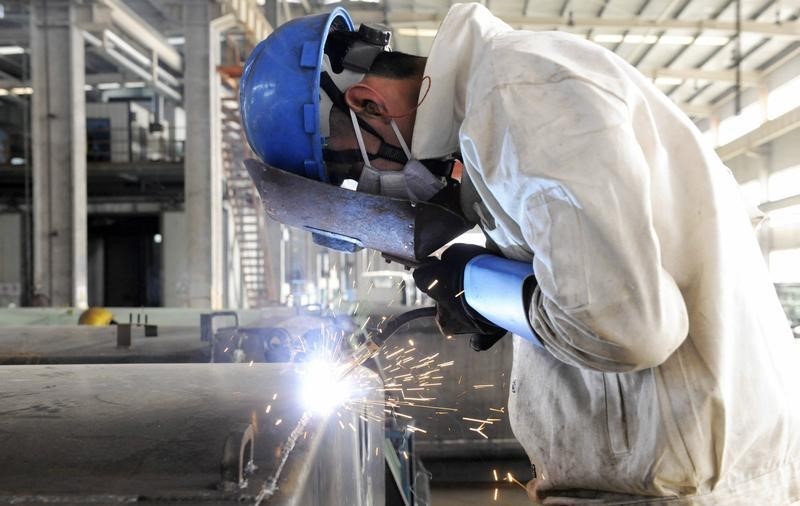By Koh Gui Qing and Pete Sweeney
BEIJING/SHANGHAI (Reuters) - Surveys of China's factory and services sectors showed stubborn weakness in the world's second-biggest economy in March, adding to bets that Beijing will have to roll out more policy support to avert a sharper slowdown.
Three separate surveys showed Chinese companies shed jobs last month as they struggled with soft demand and deflationary pressures, suggesting that economic growth may have slipped below 7 percent in the first quarter of 2015, which would be the weakest in six years.
"We expect first-quarter growth to drop to 6.8 percent and the government might start easing policies significantly in the second quarter," said Zhang Zhiwei, an economist at Deutsche Bank (XETRA:DBKGn) in Hong Kong, adding that the central bank may relax banks' reserve requirement ratio (RRR) as early as this week or next.
"Growth faces headwinds from the property slowdown and a fiscal slide," said Zhang, referring to a fall-off in government revenues that many worry could further dampen economic growth by crimping investment.
Many economists also see further interest rate cuts later this year and additional measures to help the weakest sectors such as the housing market. Regulators on Monday cut down payment requirements for home buyers for the second time in six months.
The last time China reduced the amount of deposits that banks must hold as reserves was on Feb. 4, three days after an official survey of the factory sector showed activity unexpectedly shrank to a 2-1/2-year low.
The official Purchasing Managers' Index (PMI) released on Wednesday was not as dire, but indicated that activity was tepid at best.
It edged up to 50.1 in March from February's 49.9, the National Bureau of Statistics said, stronger than a Reuters poll forecast of 49.7, but barely above the 50-point level that separates an expansion in activity from a contraction.
In another sign that businesses were facing lacklustre demand, a survey of China's services sector showed the official non-manufacturing PMI cooled slightly to 53.7 from February's 53.9, hugging a one-year low.
Both the factory and services PMIs showed companies continued to reduce staff last month. While the labour market remained surprisingly resilient for much of 2014, some economists believe any marked deterioration in coming months could prompt more aggressive easing measures from Beijing.
DEFLATION RISK
The surveys also suggested that deflationary pressures did not let up last month, pressuring firms' profit margins even as sales slow and competition heats up.
Producer prices in factories fell again in March for at least the 13th consecutive month, while the final prices of services charged by firms dropped last month.
Wary of following in Japan's footsteps, where two decades of falling prices have stifled economic growth, Chinese policymakers have signalled that they are ready to act to avoid a bruising deflationary cycle.
Central Bank Governor Zhou Xiaochuan warned on Sunday that the country needs to be more vigilant about the impact of declining prices.
SIZE MATTERS
Weighed down by a property downturn, factory overcapacity and high levels of local debt, China's economic growth is expected to slow to a quarter-century low of around 7 percent this year from 7.4 percent in 2014.
Even the services sector, which was the lone bright spot in China's slowing economy last year, appears to be finally succumbing to the broader economic downdraft, judging by the recent patchy performance of the services PMI.
Other data this year have indicated that the economy has lost momentum despite two interest rate cuts since November, a reduction in banks' reserve requirements, and repeated attempts by the central bank to reduce financing costs.
Indeed, a smaller, private survey of China's manufacturing sector showed on Wednesday that it contracted in March after two months of recovery.
The final HSBC/Market China Manufacturing PMI came in at 49.6, slightly higher than a preliminary "flash" reading of 49.2 but still below 50.
"The latest data indicate that domestic and foreign demand remains subdued amid weaker market conditions," said Annabel Fiddes, an economist at Markit.
The official PMI looks at larger, state-owned firms, while the HSBC (LONDON:HSBA) version focuses on small and mid-sized firms which are facing greater stresses such as high financing costs.
True enough, the official manufacturing PMI also showed that the downturn was worst felt among the smallest factories.

The PMI for big factories rose to 51.5 in March, while the index slipped to 48.3 for mid-sized manufacturers, and fell by the greatest margin to 46.9 for small workshops.